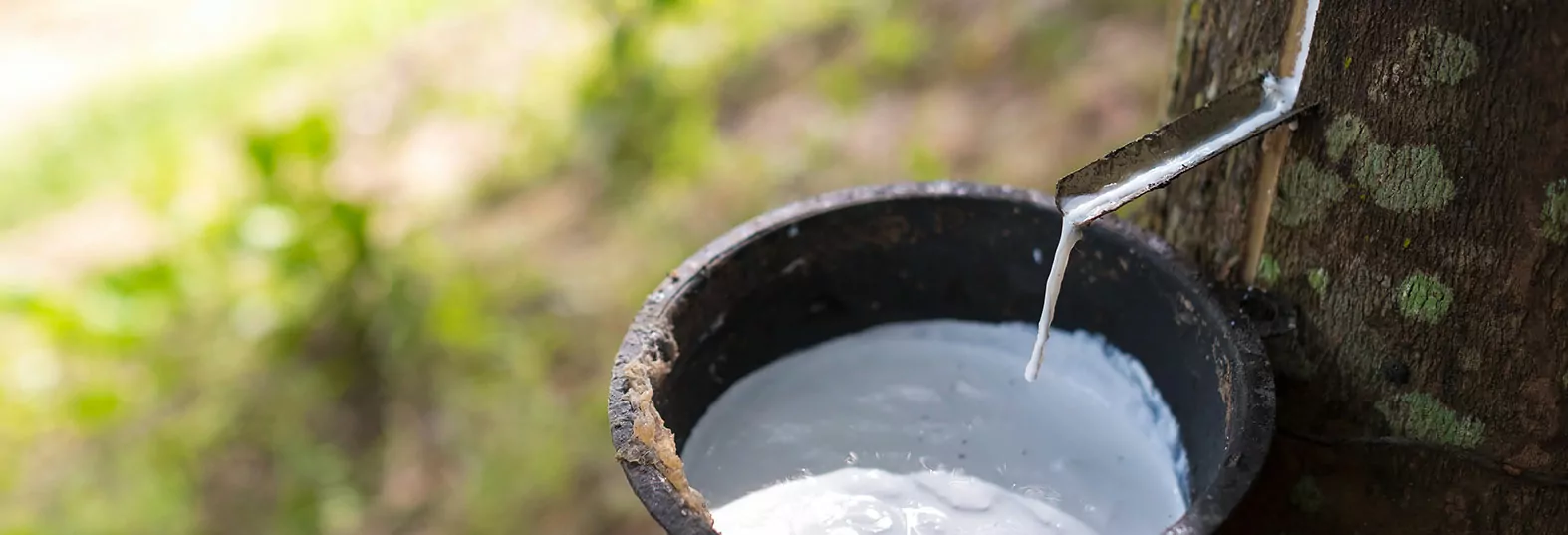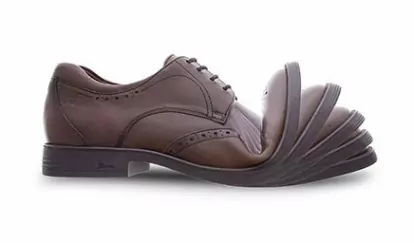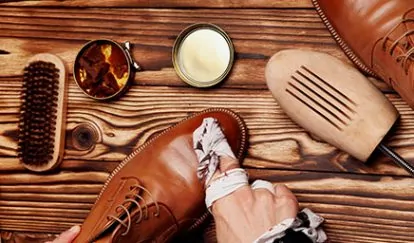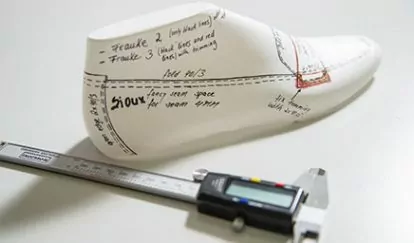CREPE SOLE
A true natural product to the core

Learn more about what is undoubtedly the most natural form of comfort - everything about this Sioux speciality can be found here.
Natural crepe soles are one of Sioux’s signiture features. Since our establishment, we have continued to use this premium natural material. Natural crepe soles have become real speciality and true rarity nowadays. Very few shoe manufacturers still offer shoes with crepe soles. They are very complex to manufacture and the soles are significantly more expensive than mineral oil based materials such as EVA, TPU or lightweight rubber. Expert knowledge and lots of experience are required for the finishing of crepe soles. For this reason, these kind of soles are mostly used exclusively in the luxury sector. They are particularly popular amongst fashion-minded men and globetrotting fashionistas. It is easy to see why - the crepe sole never fails to provide the shoe with an unbeatably natural and casual look - no matter whether it is a desert boot, ladies‘ ankle boot or the iconic shoe from the 60s: our Grashopper. A shoe with a crepe sole is a real must-have for every shoe cabinet. This is why we have been equipping our shoes with natural crepe soles for sixty years here at Sioux. All for a very reasonable price - we wouldn’t have it any other way here at Sioux.
What is a crepe sole and where does the raw material originate from?
We equip all our shoes with crepe soles with only the finest natural rubber of the highest quality. The natural rubber or crepe soles came from the idea of producing soles the same way that the indigenous people of South America did. They used the sap of the Hevea-tree for manufacturing. In order to produce the crepe sole, we only use sap extracted from the Hevea tree. These trees grow in tropical rain forests. The sap is collected by cutting thin strips of bark from the tree and allowing the latex subtance to be tapped. This harvesting does not weaken the tree, far from it, it actually helps it flourish. Each tree produces approx. 50 g of sap a day. For each pair of average-sized soles (e.g. 42), 25-30 cuts are needed. The tapped sap is constantly being reproduced by these trees and they are allowed a sufficient break for regenerating. After this period, the latex tree is tapped again. Botanists even say that this process of tapping is even known to strengthen the resistance of the tree. This works on a similar principle to bloodletting that is still used today used today in alternative medicine.
How a natural crepe sole is produced?
After the harvesting, the rubber latex is manually filtered – similarly to the process done during cheese manufacturing – and then collected in big basins. Acetic acid is then used to curdle the liquid so that it can be cut into handy blocks. This curdled latex mass initially contains 40-50% water. It is then pressed into thin sheets through a system of rollers that wrings out excess liquid – resulting in an approx. 1cm thick crepe sheet. In the next three steps, the rubber sheets are rolled over and over until they are around 1 mm thick. The resulting sheets are then dried – resembling freshly washed curtains as they do so. After around 7 days the water will have evaporated. The sheets are now sticky and ready for further processing. The sheets are now laid flat on top of each other. To create a sole that is 8 mm thick, 12 sheets must pressed together. Individual plates are cut from these sheets and the soles are cut in various sizes are punched out from these plates.
The soles are manufactured by hand one at a time. Twenty manual production steps are needed for the soles to be used for shoe manufacturing. This process is based on an old tradition. The manufacturing methods are purely mechanical and thermal, meaning that the manufacturing is completed without the use of any chemical substances. The curdling process, which requires formic acid (acidum formicum), is the only exception to this and we use a naturally occurring, bio-degradable acid for this process.

What benefits does a crepe sole have to offer?
A crepe sole is a completely natural product with extraordinary resilience and a smooth finish that ensures unbeatable comfort. What’s more, it provides ideal protection for the most complex part of the foot, i.e. the midfoot, as it supports the natural flexing action excellently.
When the foot impacts the ground, the soles act as a kind of natural shock absorber thus protecting the tendons and ligaments thanks to the thousands of air bubbles contained within them. Such an outstanding combination of features cannot be imitated or beaten by any other sole material. As far as the ergonomics of a sole are concerned, it is not only about their level of cushioning but also their resiliency. Besides the absorption, the sole also has to provide support. If the foot sinks into the sole, the arch of the foot becomes strained. Our sales representatives prefer to wear shoes with crepe sole at trade fairs as only these shoes provide them with the support to stand for eight to twelve hours per day without their feet becoming tired. Sioux has been using crepe soles since 1950. In the 1960s, all Grashopper shoes were equipped with a crepe sole. The Grashopper became not only a shoe for students but also the favoured hiking boot for the whole family.
The structure of the surface provides the crepe sole with long lasting durability. The material is open-pored and therfore has an excellent grip on slippery surfaces – very similar to the skin of a gecko. These benefits are united in a product that stands for 100% sustainability and naturalness.
As it happens, crepe soles are bio-degradable – something which cannot be said for rubber, TPU and EVA soles. So the benefits of crepe soles do not just stem from natural origin when it comes to sustainability. When they have had their day, they can decompose gracefully back into the earth.
Do crepe soles also have disadvantages?
We would not regard it as a disadvantage but there are two characteristics that should be considered when it comes to crep soles. The natural latex soles area little heavier than chemically produced outsoles (e.g. EVA, TPU or rubber – often used for trainers). You do not feel this when wearing the shoe, however, only when you held the two shoes in your hands and compared them, would you feel the difference. Shoes with a latex sole are around 60-80 grams heavier. The second aspect is that shoes with open-pored crepe soles absorb dust. We call this the patina effect. Over time, the sole reflects the long and often dusty path that the wearer has taken. You can find tips on how to protect the soles against dirt and how the sole can be cleaned here.
How should crepe soles be treated?
The crepe sole is robust and durable. It does not need any specific protection. But as it is a genuine natural product – similarly to a leather sole – it should not be exposed to any extreme environmental influences. To be able to enjoy the soles as much as possible, you should avoid contact with extremely hot tarmac (e.g. in desert areas). The shoes should not come into contact with gasoline or similar solvents – this causes damage to the surface. Crepe soles are as durable as soles made from production methods which use minerals or chemicals. The big difference can be seen in the softness, flexibility, naturalness and sustainability.
How can I distinguish between genuine crepe and artificial crepe?
Genuine crepe can be identified through its appearance (open, crinkly structure), feel (porous, high-grip) and particularly its smell (a mix of oat straw and stationary rubber). Genuine crepe outsoles come in two colours only: a light, honey-like brown and a milky, slightly yellowish white. If the colour of the crepe sole is black, then it has been dyed. Many shoe manufacturers use artificial crepe because it is considerably cheaper and easier to manufacture. Unfortunately, these artificial versions do not possess any of the exquisite features that natural crepe boasts. This is why Sioux only uses natural crepe.
To find out how to best clean your natural crepe soles, click here.
OUR PRODUCT RECOMMENDATIONS FOR YOU
How to clean a natural crepe sole
Natural crepe soles ensure recreation of the most natural way to walk or stand. One disadvantage: it is open-pored and therefore becomes gradually dirty over time.
Shoe construction techniques
Why are there so many different shoe models? The construction technique used by Sioux depends on what the shoe will be worn for and what the wearer requires from it. Because, ultimately, the shoe must have a perfect fit.
Things you should consider when buying shoes
The following 10 tips will give you a practical guide and help you with your next shoe purchase. Besides the right shoe size and width, an optimal fit, skilful workmanship and the use of high-quality materials for the upper, lining and outsole are also important factors when it comes to quality and selection. We want you to stay feeling comfortable in your shoes for as long as possible.
Crepe sole
Learn more about what is undoubtedly the most natural form of comfort - everything about this Sioux speciality can be found here.
Labelling of materials
A question frequently asked by our customers is: “How can I be sure that the material used is really genuine leather?"
The history of footwear
More than 40,000 years ago, people developed a need to protect their feet against adverse external conditions. It took several centuries, however, until the fashionable and comfortable footwear that we are familiar with today became available.
Sioux hallgus protect
The combination of high-quality leather and our innovative Sioux-Tex climate membrane will give your feet that “feel-good” feeling: whilst moisture and vapour are quickly wicked away from the shoes, water from the outside has no chance of getting in, meaning your feet are always warm and dry.
Sioux natural move system
The combination of high-quality leather and our innovative Sioux-Tex climate membrane will give your feet that “feel-good” feeling: whilst moisture and vapour are quickly wicked away from the shoes, water from the outside has no chance of getting in, meaning your feet are always warm and dry.
SiouxTex
The combination of high-quality leather and our innovative Sioux-Tex climate membrane will give your feet that “feel-good” feeling: whilst moisture and vapour are quickly wicked away from the shoes, water from the outside has no chance of getting in, meaning your feet are always warm and dry.
Shoe lining
Consumers often only pay attention to whether they like a shoe and whether it fits well. What is inside the shoe should also be a decisive factor: the shoe lining is often underestimated when buying shoes, despite being a key factor when it comes to comfort and health. Below we will explain the various types of shoe lining, their uses and the importance of shoe lining when it comes to your well-being.
Shoe soles
Whether they are a lightweight and flexible, feature unique air-cushioning or have a timeless and elegant leather sole: it's the perfect join of the shoe upper and sole which is the finishing touch to each and every shoe.
Shoe size and fit
As the foot performs a rolling motion when walking, it bears your weight in various areas and thus changes shape in doing so. The hallmark of a perfect-fitting shoe is that the toes and the foot itself have enough space within the shoe throughout this rolling motion and that the heel experiences sufficient grip. When a shoe fits, the heel does not slip out of the back of the shoe, and the shoe sits so perfectly in the midfoot area that the foot is supported – and is unable to slip forwards – hence the shoe pinching.
Shoe leather
Choosing the leather is very easy when it comes to Sioux shoes: we only settle for the best.
Shoemaking
There are lots of steps involved in making a shoe. From developing the model in the first instance, to the stamping, sewing and putting the finishing touches to the shoe at the very end.
Grashopper
In the 1960s, the natural form moccasin was a revolution. Today, the cult shoe is more topical than ever as a pioneer in modern casual wear.
 DE
DE EN
EN FR
FR NL
NL
















